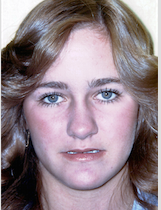 Rochelle Ihm.
Rochelle Ihm.
Second of two parts - part 1
Rochelle Ihm was 20 years old when she disappeared in July 1986 in Phoenix.
Nearly three decades later, "Rocky," as her family called her, is still missing.
But her family is like the families of thousands of the estimated 80,000 missing people in the United States - still hoping.
"Just to give you an idea of who Rocky was … this is my family having dinner in Acapulco," Rocky's sister Denise Abdelnour says, showing photographs. "That’s Rock. She was an adorable child, of course."
Abdelnour holds a handful of pictures of her family that she has kept in storage for the last few years. She hasn’t seen these particular images for a long time. She says it’s just too painful.
“This was Rocky at her essence. Not the latter blond-haired person. She was a jokester.”
Ihm is one of an estimated 2,000 missing persons in Arizona listed by the National Missing and Unidentified Persons System. That number makes the state, with Alaska, one of the two leading places in the country where people go missing.
“We know that the last person she was seen with was the gardener," Abdelnour says. "However there’s no proof that he dropped her off at the bus station.”
At the time, Rocky was living in California and came to Phoenix to visit friends one weekend in July 1986. Police said the last person to see her alive was a man who had been employed by the Ihms before family members moved away before 1986.
That man told investigators that Sunday, July 13, he drove Rocky to the Greyhound station in downtown Phoenix. She has not been seen since, and no charges have ever been made in connection with her disappearance.
“The Phoenix police, at that point in time, were talking ... “Oh well, she probably ran away with a boyfriend,” Abdelnour says, adding that police did not seem to take Rocky's disappearance seriously.
"Weeks, months, days passed and no word. No word from her whatsoever,” her sister says.
Abdelnour says her sister’s case now is being handled extremely well by the police, but in 1986, missing persons cases were not treated as they are today.
"My mother did not have a great experience with the Phoenix Police Department at that time in the 80s, unlike the detailed attention that is given in this day and age by the detectives that are actually assigned to missing persons cases," she says. "And as we know now the first 48 hours are the most crucial and critical of someone going missing.”
In the years that followed Rocky's disappearance, Abdelnour’s mother began keeping meticulous notes on the case, essentially conducting her own private investigation. She says her mother was tireless, writing to the FBI, even Arizona Sen. John McCain, asking for help from federal authorities in the search for her daughter.
Abdelnour says her family was disappointed by the response from federal investigators. Like many families, the Ihms were surprised to find the system of searching for missing persons was complicated, and unless they could prove a federal crime occurred, national agencies would not get involved.
“As the letter from the U.S. Justice Department said, they assist when it becomes a federal case," she says. "However, it’s in the hands of local authorities, who may or may not have the resources to research those sort of disappearances.”
Rocky Ihm’s disappearance has not been solved. Abdelnour says the case is still being investigated by Phoenix police detectives. And, in the wake of her parents' deaths, Abdelnour is taking up the search.
“You know every phone call you receive, there’s always that hope," she says. "I’m the last remaining member of my family in the U.S., and I just feel it’s my responsibility to find out what happened to her before I leave this Earth, not that I’m planning on doing that any time soon. I’d like to have this resolved or at least it would be nice to know what happened to her and to put it to rest.”
Abdelnour asks that anyone with information about what may have happened to Rochelle Ihm to contact the Phoenix Police Department.

By submitting your comments, you hereby give AZPM the right to post your comments and potentially use them in any other form of media operated by this institution.